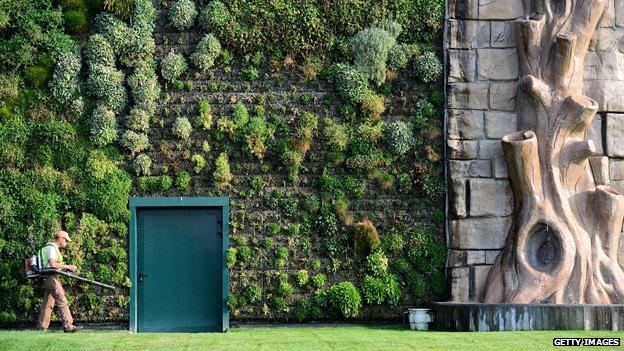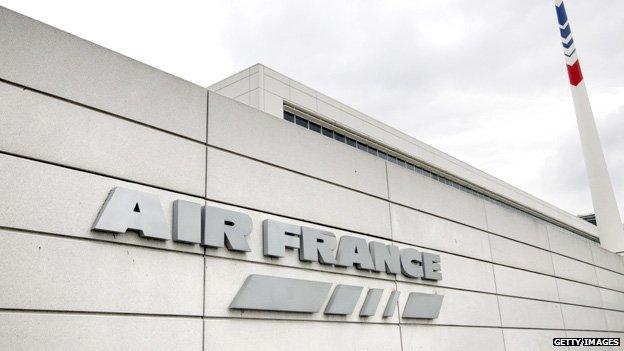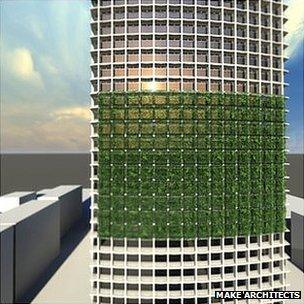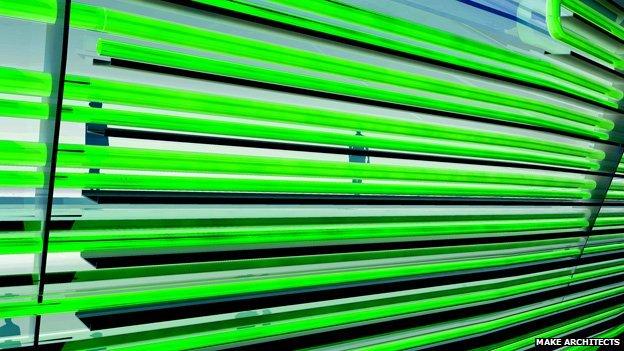Edible edifice: Building the offices of tomorrow
- Published

Urban eats: Could you find yourself tucking into lunch grown on the walls of your office in the not-too-distant future?
There's a lot of debate over what place the office might have in tomorrow's working landscape.
As technology makes flexible working easier, the maxim: "Work is not where you go, it's what you do," looks ever more realistic.
But one thing that might hurry the flight from the traditional office is the thought your canteen could be serving up meals grown on the walls of the building.
While you may have a sneaking suspicion the catering staff already do this, there is a real chance such delicacies will feature on the menu some time soon.
Intelligent buildings
This culinary delight was one of a number of concepts presented at a recent British Council for Offices conference, where delegates looked at the next generation of "intelligent" buildings.
"This is not just about automation, an igloo could be said to be an intelligent building," says Derek Clements-Croome, emeritus professor at the University of Reading.
"These buildings will respond to the needs of people, there will be an increased amount of personalisation - you will be in control of the environment and be able to tune it to your needs."
This means your office may look very different indeed in a few years.

Prof Derek Clements-Croome: "These buildings will respond to the needs of people"
Designers talk of digital walls, which have sensors embedded so you can interact with them.
Or, if you want the professor's technical explanation, "dye sensitised solar cells with titanium oxide layers on a surface with light absorbing dye molecules adsorbed on surface which can generate electricity".
These walls will build up a profile of you and change your working environment accordingly.
This could mean the lighting around your desk dims slightly when you arrive, or a pre-determined microclimate is created for your meeting.
Nano state
The technology that enables this interaction, known as "nano-coating", will basically turn your cold, unfeeling office into an expressive medium
It could mean the moment you enter the building your workspace starts preparing itself for your imminent arrival - even if you are hot-desking.
This is far from being science fiction, according to John Monaghan from Cisco, who is already pushing ahead with such technology.
"When someone walks in [our technology] can recognise who they are and then offer them the appropriate level of service," he says.
"It's about creating a seamless pleasant user experience."
And that's just on the inside.
The building industry is latching onto advances made by other industries like aviation to create innovations such as self-healing and self-cleaning materials.

The Air France headquarters at Roissy-Charles de Gaulle Airport near Paris is made of self-cleaning concrete
Self-cleaning concrete, for example, uses titanium dioxide to break down unsightly pollution into its chemical constituents, which rain then washes off the walls.
A noted example is the Air France headquarters at Roissy-Charles de Gaulle International Airport near Paris, which has remained white despite all the attendant aviation pollution.
All of which brings us to why your meal options in the canteen might benefit from this evolving building technology.
Lunch time
Sean Affleck, from Make architects, is a big fan of "living facades".
He describes these as "vertical fields", where plants are grown up the walls, absorbing carbon dioxide (CO2) and releasing oxygen as they go.
This could help in the fight against global warming Mr Affleck says.
"Growing living facades could cool cities down like in a forest, where you find cool woodland glades because of all the evaporation going on around you," he says.

Vertical gardens like this could help cool cities
A similar option is harnessing the green power of algae.
"Algae is 200% better at absorbing CO2 and producing bio-mass than, say, oil seed rape," Mr Affleck says.
He envisages buildings wrapped in algae tubes, into which gaseous waste products from the building are pumped.
The algae, having done its cleansing work, would then be harvested for power.
One example where this is already happening is the Red Hawk power plant in Arizona, USA.
There carbon dioxide rich gases created during production are passed through tubes of algae, which take out 80% of the gas and release oxygen.
The algae is then recycled through biomass generators to create biodiesel.
But if we don't want to turn our offices into power plants, there are other applications.
Mr Affleck cites a project in Mumbai (Bombay), India, where a firm is turning algae grown on fences wrapped around the building into cosmetics.

Algae-filled tubes could be used to absorb the CO2 produced by buildings, then used to produce biofuels
And, returning to the culinary theme, you could also turn it into products like spirulina jam - perfect on your lunchtime pasta.
Pushing plant use even further, some suggest using their roots to fix buildings to the ground.
If that sounds ridiculous, proponents point out trees tend to survive earthquakes when offices do not.
Innovation barriers
Of course there are numerous barriers in the way to any of these advances, one of which is simply taking the plunge in the first place.
"A lot of the best ideas demand someone takes a big risk," says Andrew Hunter, technical services director at Skanska.
"They lose a lot of money and the rest of us pick up the pieces."
But there are major drivers that could mean these intelligent buildings are on the way.
The first is economics, as offices tend to be a company's second most expensive cost after staff.
Buildings that are automated and where systems effectively interact not only with you, but with each other as well, could ultimately be cheaper to run.
They will use less energy and water, and create less waste.
Meanwhile the more pleasant working environment they foster will encourage higher productivity.
Secondly, issues such as energy, water and waste management are key parts of companies' sustainability agendas.
They are likely to grow in importance as the threat of global resource shortages advances and environmental concerns build.
Innovative use of buildings could help head off such risks and make a positive contribution at the same time.
"We talk about being carbon neutral now, but if we look at buildings being power generators themselves in the future, suddenly we are thinking about being carbon positive," says Prof Clements-Froome.
The elephant in the conference room at the British Council for Offices remains the question of whether we will still be heading into the office at all in the future.
Unsurprisingly, the architects, designers and IT experts at the Intellibuild event seem unanimous in their disdain for the idea, citing the innate need for humans to congregate and engage with one another.
Although perhaps not over a bowl of algae spaghetti.